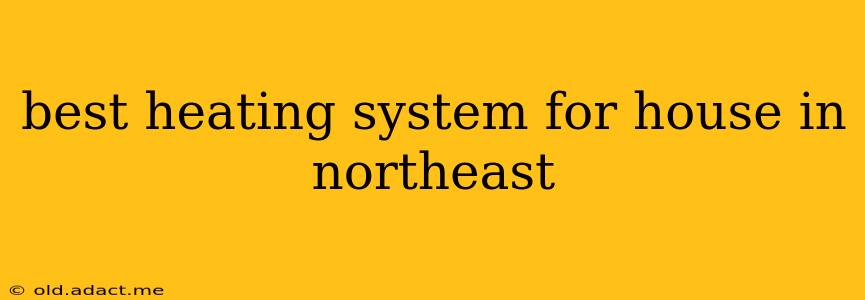Best Heating System for a House in the Northeast: A Comprehensive Guide
The Northeast US experiences notoriously harsh winters, demanding a robust and efficient heating system to keep your home comfortable and your energy bills manageable. Choosing the right system depends on several factors, including your home's size, construction, budget, and personal preferences. This guide explores the best heating options for Northeast homes, addressing common questions and concerns.
Understanding Northeast Climate Challenges:
The Northeast's climate presents unique challenges for heating systems. We face prolonged periods of freezing temperatures, significant snowfall, and fluctuating humidity levels. A reliable system needs to withstand these conditions and provide consistent warmth throughout the long winter months.
What are the most efficient heating systems?
Efficiency is key, especially considering the region's energy costs. High-efficiency systems translate to lower operating costs and a smaller environmental footprint. Several options consistently rank high in efficiency:
-
Heat Pumps: These are becoming increasingly popular due to their versatility. Air-source heat pumps efficiently extract heat from the outside air even at lower temperatures, transferring it inside. Ground-source (geothermal) heat pumps are even more efficient, utilizing the stable temperature of the earth. While initial investment is higher, long-term savings can be significant.
-
High-Efficiency Furnaces: Modern furnaces, particularly those with condensing technology, boast significantly higher AFUE (Annual Fuel Utilization Efficiency) ratings than older models. Look for ratings of 95% or higher for optimal efficiency. Natural gas furnaces are generally more cost-effective to operate than oil furnaces in the Northeast.
-
Boilers: Boilers heat water or steam, distributing it throughout the home via radiators or radiant floor heating. While potentially less efficient than high-efficiency furnaces in some cases, they offer consistent, even heat and can be combined with radiant floor systems for ultimate comfort.
What is the cheapest way to heat a house in the Northeast?
The "cheapest" option depends heavily on initial costs versus long-term operating expenses. While a simple electric baseboard system might have low upfront costs, its operating expenses can be significantly higher than other options, particularly during extended periods of cold weather. Natural gas furnaces often offer a good balance of affordability in both initial investment and ongoing operational costs, assuming access to a natural gas line.
What type of heating system is best for a new construction home in the Northeast?
New construction offers the flexibility to plan for optimal heating efficiency. This frequently leads to incorporating:
-
Radiant Floor Heating: This system provides even, comfortable heat throughout the home, minimizing drafts and hot/cold spots. It works well with boilers or heat pumps.
-
High-Efficiency Heat Pumps: These are an ideal choice for minimizing long-term energy consumption in new constructions. Careful consideration of the heat pump's capacity for low-temperature operation is crucial for Northeast winters.
What is the best heating system for an older home in the Northeast?
Older homes often present challenges in terms of insulation and air sealing. Addressing these issues before installing a new heating system is paramount. Options to consider for older homes include:
-
High-Efficiency Furnaces (with potential ductwork upgrades): Replacing an older, inefficient furnace is a significant upgrade. If ductwork is compromised, consider upgrades to improve airflow and efficiency.
-
Heat Pumps (with careful consideration): Heat pumps can work in older homes but may require supplementary heating on the coldest days. A thorough assessment of the home's insulation and air sealing is critical before deciding on a heat pump.
-
Zoned Heating: For homes with uneven heating needs (different rooms used at different times), a zoned heating system allows for controlling temperature independently in different areas, increasing efficiency and comfort.
What are the different types of heating systems?
The main types of heating systems commonly used in the Northeast include:
-
Forced-air systems (furnaces): These systems use a blower to circulate warm air through ductwork.
-
Hydronic systems (boilers): These use water or steam to distribute heat through radiators or radiant floors.
-
Electric baseboard heaters: These are simple systems but generally less energy-efficient.
-
Heat pumps: These use electricity to move heat rather than generate it, offering greater efficiency.
This guide offers a starting point for choosing the best heating system for your Northeast home. Consulting with a qualified HVAC professional is crucial to assess your specific needs and determine the most efficient and cost-effective solution. Remember to factor in factors such as home size, insulation levels, fuel availability, and your budget when making your decision.
